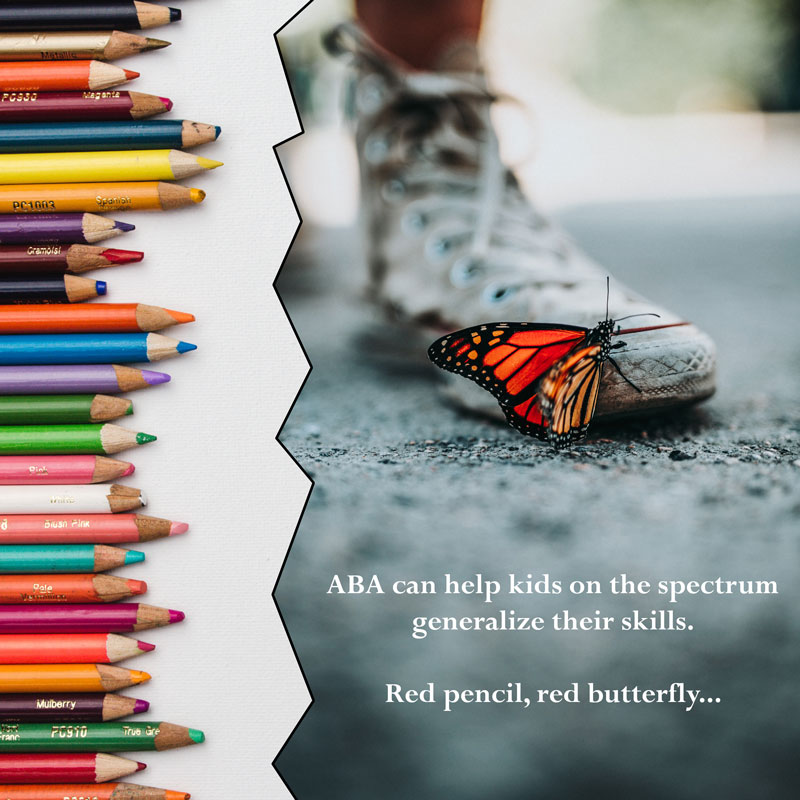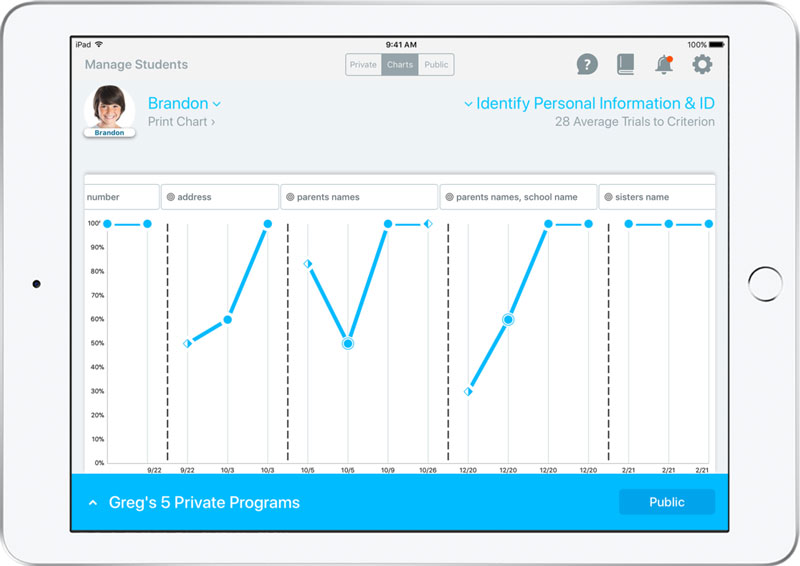ABA is a scientific research-based set of principles to help build socially significant behaviors that are meaningful for individuals and families. This article will focus applications for autism, but ABA is based on the study of all human behavior and is widely used in other settings.
What is Applied Behavior Analysis (ABA) and how does it work?
What if you heard a knock at the door, opened it, but no one was there? Later that morning, another knock; again, no one. After a while, if this continues, most of us would begin ignoring the knock. Why? Because the reason we opened the door was an expectation of greeting someone or finding a package. Without that, why respond?
ABA is used by many teachers and therapists with children on the autism spectrum or diagnosed with Autism Spectrum Disorder (ASD). It begins with the concept of contingency, or the cause-and-effect relationship between events. ABA is a complex science with its roots in the simple premise that all behavior is shaped by our personal history with cause and effect. This dynamic is often referred to as the ABC’s of ABA.

The ABC’s of ABA
Let’s look at the ABC’s of ABA in the context of answering the door.
A – Antecedent: The antecedent is the cause; it’s what happened just before the behavior. In our example, the antecedent is a knock at the door.
B – Behavior: This is what we do in response to the antecedent. In our example, we open the door.
C – Consequences: The consequence is what happens directly after our behavior. Usually, after the knock we open the door and see a visitor. The visitor is the consequence, or the reinforcement for continuing this behavior.
Benefits of ABA
This article introduces some basic concepts and benefits of expertly applied ABA therapy. It does not seek to present ABA as the only therapy available, or the best match for your needs.
The science of ABA prescribes methods, not goals
Every child has unique learning needs. In addition, there are differing views about curriculum content and which behaviors or skills are important for children diagnosed on the autism spectrum. However, curriculum and goals should not be confused with method.
Instructors, therapists, parents and others using ABA can design or adopt a curriculum within the structure of ABA science to align with any instructional or behavioral goal.
Guidelines for ABA have evolved in many directions
Today’s ABA is so much more than an instructor and student sitting on opposite sides of a table with flash cards and a notepad. For clarity this article will offer simple ABA examples but the science is complex and has evolved in various ways based on theory and application.
For example, Natural Environment Teaching (NET) is a teaching methodology that focuses on creating and capturing moments in the environment conducive to learning. An instructor may set up a learning environment with different activity choices. Lessons are offered based on choices the child makes during the session, and similar lessons are later offered in other settings to reinforce and generalize the concepts.

Other ABA tools include Verbal Behavior therapy (VB), Discrete Trial Training (DTT), Pivotal Response Treatment (PRT) and more.
Different ABA program types are used as tools to fit various situations. For example, a Task Analysis strategy may be used to teach skills that can be broken down into steps. Often adding steps will help a task become manageable. For example, “put your shoes on” may be broken down into 1) find your shoes on the shelf, 2) determine which shoe is left vs. right, 3) loosen the laces, 4) pull the tongue forward, 5) insert your toes, 6) pull the shoe toward you… etc. Maybe today we master steps 1-4, and tomorrow we run through steps 1-6. This gives us opportunities to reward success even before the entire task is mastered.
A positive bond between instructor and child is key
Pairing is a key concept in ABA that refers to the bond or relationship between instructor and child. Building a positive relationship is one of the first goals of therapy or instruction, in order for the child to associate the instructor with good experiences and look forward to their time together.
For this reason, the pairing process generally focuses on relationship building and plenty of positive reinforcement.
ABA seeks to understand each child as an individual
We don’t all enjoy or dislike the same things in life. In fact, a reinforcer for you may be punisher for me. Here is an example we may all relate to; let’s set the stage.
Jane and Rachel both submit fabulous reports at work. Their manager wants to recognize them for it, and – this is key - wants to encourage them to continue performing at that level. To that end, she arranges for each to present their reports at the podium in front of 500 people at next month’s all-staff company meeting.
Jane has always loved public speaking and is overjoyed. She works even harder as the date approaches. Rachel feels slightly nauseated, begins having trouble sleeping at night, and her work suffers. Clearly, positive reinforcement for Jane is punishment for Rachel.
ABA professionals know that children diagnosed with ASD are just like Jane, Rachel, and all of us. They are trained to get to know each child and select methods to reinforce behavior in a way each child will find motivating. While Ricky may love a cartoon character stamped on his hand, Josh may dislike his hand dirtied with ink. April might be motivated by verbal compliments, and Terry may prefer to work toward free play time.
ABA focuses on positive reinforcement and rewarding good behaviors to encourage them to be repeated. We talked earlier about how important the pairing or relationship-building stage is between a child and instructor. Learning what motivates or discourages each child is a critical building block in this process.
ABA seeks to generalize skills for broad application
Effective ABA instruction seeks to generalize a child’s learning to various real life situations. A lesson on identifying colors, for example, may begin with a familiar set of objects like cards or blocks. Once colors are mastered in that setting, the lesson is continued (or generalized) to other situations.

Generalization is a common deficit for children on the autism spectrum. ABA therapy specifically targets this deficit during teaching. Let’s say a child learns to identify red using an array of colorful paper. The next step may be identifying red crayons during a coloring session, or red blocks while building a tower. On an outing, the instructor and child might play “I Spy” in a game to identify the colors of random objects. Later, the child may spontaneously include “red” while describing his favorite type of fruit.
These are all different levels of mastery as the child generalizes the concept of color. The ABCs of the lesson plan will be adjusted as they move through those learning phases.
ABA helps children be independent
Children who grow up with learning disabilities are less likely to act independently. This is complicated by the fact that it’s easier and more convenient for caregivers to do a task for the child than it is to teach the child how to accomplish the task by themselves. This phenomenon is known as “learned helplessness.”
Help is very important because no child can accomplish everything on their own, but direct assistance should be balanced by careful consideration towards the child’s autonomy. ABA is very often applied to provide this balance by skill-building toward the goal of independence. Lessons may include personal tasks like getting dressed, toileting, or bathing. Older children and young adults may work on choosing groceries for a recipe, paying at the checkout line, or cooking a meal.

Fading of prompts and reinforcement is a key strategy for promoting independence. At first, a prompt could involve a vocal cue like “please get your shoes on” along with a physical prompt like placing the child’s hand on their shoes. Later the prompt may be simply “please get your shoes on” or even, “let’s get ready to go.” Similarly, at first a reward may be needed every time, then only occasionally. Once the skill is mastered, no reinforcement may be needed at all.
Each child is evaluated to assess their current level of independence before sessions begin in order to plan a customized curriculum. Reassessment is built into the program to determine progress and adjust goals accordingly.
ABA helps children build social skills
Children diagnosed with ASD may experience varying difficulty interacting with others. Effective ABA programs should teach and reinforce positive social skills in specific situations, and then generalize those skills for real world application. Some examples include having a conversation with a friend, peer or family member, understanding emotion or reading facial expressions, cooperative game play (e.g., turn-taking), imaginative play with peers (e.g., playing house or dress-up), tolerating being near other people, or greeting people appropriately.
It is important to remember the science of ABA does not prescribe which socialization goals a child on the autism spectrum should be taught. The instructor or therapist selects the curriculum and goals for the child within an ABA learning framework. This is best determined through a careful evaluation of the child’s special needs along with the family’s own values and priorities.

ABA provides a framework for parents and teachers
ABA programs are written to provide a framework for parents and teachers to handle learning opportunities in a structured, repeatable way. Many details are considered and documented, including environmental factors, short and long term objectives, steps or learning targets, methods of reinforcement and more.
The outcome or success of a learning session can be affected by any of these factors, and ABA professionals are trained to look for trends and make adjustments when necessary. For example, a child may be having trouble learning the color red while building a block tower in a busy play area. The instructor may move the session to a quiet space, keeping all other factors the same. If tolerating a busy environment is one of the goals then at some point the lesson might be moved back to the original area.
Data collection is essential to ABA and keeps learning on track
ABA professionals are tasked with setting short and long term goals and documenting every aspect of the lesson plan. In addition, they must be alert to trends over time and make constant adjustments based on the child’s development.
This brings us to data collection, the cornerstone of effective Applied Behavior Analysis. ABA instructors are tasked with unobtrusively collecting every response or score in real time during each session.
Situation-appropriate data collection tools
Progress is measured using the right data collection tools for each situation. We might record the percent correct with a quick plus/minus (+/-) score each time a child correctly identifies red vs. blue in repeated trials or attempts. If instead we use a timer to measure how long a child stays engaged, it’s a duration program. If we document how many times during the session a child throws a toy or bites, that is a frequency program.
Alternatively, an interval strategy may fit best when it’s impractical to record every instance of a behavior. For example, an instructor may scan the classroom every five minutes to see if all students are focused on their exams. Or, we can record whether an extremely frequent behavior occurred in each 5 minute period rather than counting every incident.
These are just a few examples of data collection strategies and when they might be used.
How data are used
Reliable data enables the instructor to truly customize each session based on objective evidence of progress. Charts are created to show quickly and visually when targets are mastered vs when a learning strategy is not working. For behaviors targeted for increase, a trend line that declines or stays flat tells the instructor to introduce a change. This may mean modifying the learning targets, environment, prompt level, reinforcement type or something else. In short, expert use of data ensures that sessions are optimized for best results.

Innovations today
Today, innovations in the field include time saving data collection apps that create charts in real-time. This allows an instructor to make informed changes on-the-fly rather than having to create charts manually later from hand-written notes. Modern tools can automatically alert an instructor when a program change might be needed, enable collaboration between caregivers, and provide ready-made progress reports for parents.
Covered under many health plans and IDEA funding
Applied Behavior Analysis is a well-established therapy that is widely recognized by the US education system and US health insurance companies. Check with your insurance provider about coverage for ABA therapy vs. alternatives.
The Center for Disease Control and Prevention (CDC) on its Treatment for Autism Spectrum Disorder page states,
“A notable treatment approach for people with ASD is called applied behavior analysis (ABA). ABA has become widely accepted among health care professionals and used in many schools and treatment clinics. ABA encourages positive behaviors and discourages negative behaviors in order to improve a variety of skills. The child’s progress is tracked and measured.”
In addition, the Individuals with Disabilities Education Act (IDEA) mandates that every state in the U.S. must provide early intervention services to children with qualifying developmental delays, along with free and appropriate education (FAPE) in the least restrictive environment (LRE). ASD is often a qualifying diagnosis, and ABA is a common therapy used by early intervention professionals. The CDC offers this link to learn more about early intervention services that are authorized and funded by law in every U.S. state and territory.

Photography credits: Colored pencils: kelli-tungay-324329-unsplash, Butterfly on shoe: nathan-dumlao-264909-unsplash, Climbing wall: rachel-430962-unsplash, and professional stock images.
By the team at Thread Learning, Inc. with contributions by Sue Lacy, Communications Director at Thread Learning; by Andrea Netzer-Kotler MS Ed, LBA, BCBA, Director of Training and Development at Proud Moments ABA; by Noor Syed, Ph.D., BCBA-D, Lehigh University Autism Services